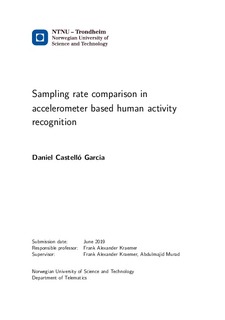| dc.description.abstract | Human activity recognition aims to identify patterns in data generated through human activity. This activity commonly describes movement and can be gathered through a plethora of sensors. Given their low price and accessibility, accelerometers are frequently the sensor of choice in studies aiming to analyze and classify human activity. When body-worn, these sensors are part of small systems that must gather data and transmit it in real-time through wireless networks, and whose battery usage is of critical importance.
Proposed in this master's thesis is a comparison of systems that aim to recognize and classify human activity, but make use of lowered amounts of data. Fewer data samples are used in order to save battery and allow for lengthier usage of the sensors, but have a negative impact on the performance of the classifier.
By comparing multiple implementations with different parameters, this master's thesis proposes six systems that have near-state-of-the-art performance, with F-1 scores over 87%, and use as little as 1,910 samples to label over 24h of human activity. Compared to previous studies, a loss of 2% precision is accompanied by 30 times more efficient battery usage and is considered a beneficial compromise for future systems.
Throughout this master's thesis over 16,000 different systems are tested, in which different sampling rates, window sizes, and window distances are varied to observe the effects on the system's performance. Certain implementations appear to have common traits that make them more resilient to using lower amounts of samples, such as the usage of longer windows with lengthier window distances. | |
